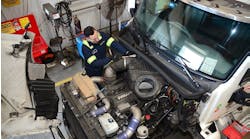Basically an extension of a vehicle's drivetrain, a power take-off (PTO) is a mechanical gearbox that attaches to apertures provided on truck transmissions. PTOs are used to transfer the power of the vehicle engine to auxiliary equipment, such as snowplows, winches, air compressors, hoists, vacuum pumps, cranes and lifts.
A PTO has to be able to transmit a sufficient amount of power to operate the particular piece of auxiliary equipment. Consequently, PTOs are available in many sizes and with various capabilities to meet output requirements.
There are many reasons why it is important to specify and order the correct PTO for the intended application, and then to have it properly installed and maintained. Key among these is to have:
- A lengthy, productive lifecycle with optimal operation.
- No, or minimal, vehicle downtime.
- Lower overall cost.
NEED TO KNOW
Here is a best practice for analyzing any PTO application:
- Note the make and model of the transmission that will get a PTO. The reason being: a PTO essentially serves as an extension of a vehicle’s transmission and transmits its power to the output shaft.
The transmission’s make and model number can be found on the manufacturer’s tag on the transmission itself. With a new vehicle, this is on the build sheet. Be sure to note any model prefixes or suffixes.
The local truck dealer also may be able to identify the transmission through the Vehicle Identification Number (VIN).
- What type of equipment is to be driven by the PTO?
- What is the input horsepower required by this piece of equipment?
A PTO’s horsepower is directly proportional to the output shaft rpm. Therefore, the faster it turns, the more horsepower is produced.
The formula to determine the horsepower (hp) is:
hp = torque (T) x rpm ÷ 5,252.
PTOs are typically rated according to torque capacity. In simplest terms, torque is that amount of force needed to make something move or run. Torque is directly related to horsepower and rpm.
Be advised, a PTO’s torque rating is constant, regardless of how fast the output shaft is turning. Torque is the limiting factor. If torque loads are too large for too long, the PTO can be damaged.
The formula to calculate torque is:
T = hp x 5,252 ÷ rpm.
Pumps, like most other PTO-driven equipment, require a fixed amount of horsepower and input speed (rpm) to produce a required flow of fluid measured in gallons per minute (gpm). The formula for this is:
Pump input hp = gpm x psi ÷ 1,714 ÷ pump efficiency.
- Determine the desired input speed of the driven equipment.
- Determine the approximate engine speed desired during operation of the equipment.
This speed can increase, decrease or directly transfer the speed needed to move the equipment to be driven by the PTO. As such, the relationship is figured as a percentage of the desired engine speed during the PTO duty cycle.
The formula to use is:
Equipment speed ÷ engine speed = PTO speed.
By way of example, if the required speed for a pump is 1,000 rpm and the engine operating speed is 1,500 rpm, the percentage of PTO speed to engine speed is approximately two-thirds, or about 67 percent.
Conversely, if a pump requires 1,500 rpm and the desired engine operating speed is 1,000 rpm, the PTO will need to be rated at approximately 150 percent of engine speed.
- Determine the PTO direction of rotation of the device being driven in relation to direction of engine rotation.
There are two directions:
- Engine – The driven equipment rotates clockwise (right-hand rotation).
- Opposite the engine – The driven equipment rotates counterclockwise (left-hand rotation.)
A geared adapter, which adds a gear set, can be used to change the rotation. Another alternative is to use a PTO that has forward and reverse gears.
When considering a PTO’s direction of rotation, spec the PTO looking from the rear of the truck to the front of the truck. The driven equipment is spec’d looking from the front of the truck to the rear of the truck.
- What will be the type of connection between PTO and the driven equipment: driveshaft (remote) or direct mount pump flange?
- Where will the PTO be mounted on the transmission: left, right, top, bottom or countershaft?
- Will the PTO duty cycle be intermittent or continuous?
Intermittent duty cycles are considered those that last for less than five minutes at a time a few times a day.
For intermittent operations, the torque requirements of the driven equipment can be determined using this formula:
T = hp x 5,252 ÷ PTO output rpm.
Continuous duty applications reduce the PTO’s torque and horsepower ratings. If these are miscalculated, the lifespan of the PTO will be less than expected.
If the torque requirements are continuous – more than five minutes operation every 15 minutes, multiply the torque figure by 0.7. The result will be the torque required for continuous operation.
10. Determine if the PTO will need speeds or reverse gear requirements.
11. What is the method by which the PTO will be engaged? PTOs can be engaged by means of a cable, air pressure, electric solenoid or hydraulic pressure.
Properly specified and installed, PTOs require little maintenance. Check the PTO periodically for evidence of oil seal wear and loose or misadjusted shifting linkage.
If a hydraulic pump is direct coupled to the PTO, it should be removed every 90 to 180 days, depending on frequency of use, and the spline coupling re-greased.
Never hesitate to contact a truck dealer, OEM or PTO supplier for assistance and guidance with selecting and properly maintaining a PTO.
Contributing to this article were:
- Dave Douglass, director of training and education, Muncie Power Products (www.munciepower.com), a leading manufacturer of power take-offs, hydraulic components – such as pumps, motors, cylinders, valves and reservoirs – and snow and ice removal products.
- Jeff King, marketing manager, Chelsea Products Division of Parker Hannifin (www.parker.com), a leading global diversified manufacturer of motion and control technologies and systems. Chelsea is a global innovation leader in power take-off technologies.




